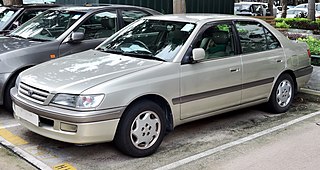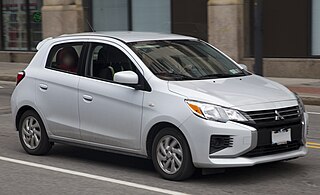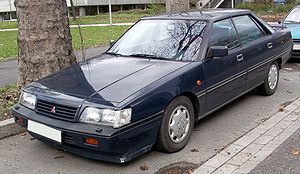
Plymouth was a brand of automobiles produced by Chrysler Corporation and its successor DaimlerChrysler. The brand was launched in 1928 to compete in what was then described as the "low-priced" market segment that was dominated by Chevrolet and Ford. It became a high-volume seller for the automaker until the late 1990s. Plymouth cars were marketed primarily in the United States. The brand was withdrawn from the marketplace in 2001. The Plymouth models that were produced up to then were either discontinued or rebranded as Chrysler or Dodge.

The Mitsubishi Galant is an automobile which was produced by Japanese manufacturer Mitsubishi from 1969 until 2012. The model name was derived from the French word galant, meaning "chivalrous". There have been nine distinct generations with total cumulative sales exceeding five million units. It began as a compact sedan, but over the course of its life evolved into a mid-size car. Initial production was based in Japan, with manufacturing later moved to other countries.

The Mitsubishi Diamante is an automobile that was manufactured by Mitsubishi Motors from 1990 to 2005.

The Mazda Capella, also known as the 626 in Europe, North America and Southeast Asia, is a mid-size car that was manufactured by Mazda from 1970 until 2002. Sold in the Japanese domestic market under the Capella name, the vehicle was also commonly known in other major markets as the Mazda 626. Ford, Mazda's partner at the time, also used the Capella platform to create the Ford Telstar and Ford Probe. 4,345,279 of the 626 and Telstar models were sold worldwide.

The Dodge Colt is a subcompact car that was manufactured by Mitsubishi Motors and marketed by Dodge for model years 1971 to 1994 as captive imports. Rebadged variants include the Plymouth Champ and Plymouth Colt, both were marketed by Plymouth.

The Chrysler Sebring is a line of mid-size automobiles that was sold from 1995 through 2010 by Chrysler. Three generations of convertibles, two generations of sedans, and two generations of coupes were produced. Although the coupe shared the same name and some styling cues, it was mechanically unrelated to the other Sebring models.

The Toyota Corona is an automobile manufactured by the Japanese automaker Toyota across eleven generations between 1957 and 2001. On launch, the Corona was Toyota's second-highest product in their range, just below the Crown. The Corona was marketed in the JDM at Toyota's Toyopet Store dealership channels, and the Corona was one of Toyota's first models exported to other global markets, followed by the smaller Toyota Corolla.

The Mitsubishi Galant Λ (Lambda) is a two-door, four-seat hardtop/notchback coupé built by Mitsubishi from 1976 until 1984. From 1978, it was exported under various names; such as the Mitsubishi Sapporo in Europe and South America, the Dodge (Colt) Challenger and Plymouth Sapporo in North America and Puerto Rico, and the Chrysler Sigma Scorpion, Chrysler Scorpion and later the Mitsubishi Scorpion in Australia. It was also sold as a Sapporo in the United Kingdom under the Colt brand.

The Subaru Leone is a compact car produced by the Japanese car manufacturer Subaru from 1971 to 1994. The word leone is Italian for lion.

The Mitsubishi Lancer is an automobile produced by the Japanese manufacturer Mitsubishi Motors from 1973 to 2024.

The Toyota Sprinter is a compact car manufactured by Toyota as a variant of the Toyota Corolla. Exclusively sold in the Japanese domestic market, the Sprinter was aimed to be sportier than its Corolla sibling and also using different sheet metal mostly on the C-pillar. The Sprinter and various body styles were exclusive to Toyota Auto Store until 1977 when the Toyota Chaser took the top position. The Corolla is similarly unique to Toyota Corolla Store until the Toyota Celica was offered in 1970, which took the top position. In 1998 Toyota Auto Store and Toyota Vista Store were both replaced by Netz Store.

The Mitsubishi Mirage is a range of cars produced by the Japanese manufacturer Mitsubishi from 1978 until 2003 and again since 2012. The hatchback models produced between 1978 and 2003 were classified as subcompact cars, while the sedan and station wagon models, marketed prominently as the Mitsubishi Lancer, were the compact offerings. The liftback introduced in 1988 complemented the sedan as an additional compact offering, and the coupé of 1991 fitted in with the subcompact range. The current Mirage model is a subcompact hatchback and sedan and it replaces the Mitsubishi Colt sold between 2002 and 2012.

The Chrysler Sigma is a version of the Mitsubishi Galant automobile that was built by Chrysler Australia in Adelaide, South Australia from 1977. When Mitsubishi Motors Australia (MMAL) took over Chrysler Australia's manufacturing facilities in 1980, they renamed the vehicle the Mitsubishi Sigma. The range was progressively discontinued and replaced by the Mitsubishi Magna, starting with the sedan in 1985 and the wagon in 1987.

Mitsubishi Sigma is a model name that was used by the Japanese automobile manufacturer Mitsubishi Motors between 1976 and 1996. Mitsubishi has utilized the "Sigma" name on several different vehicles based on Mitsubishi Galant and Mitsubishi Diamante sold in various markets during this time. The GSX-R 2.0 turbo model was fitted with a Single Overhead Cam cyclone motor which was the precursor to the infamous 4G63T twin cam motor. The 1987 model had a wheelbase that would be ideally suited to FWD street drifting. Passengers would often question life choices and later refer it as 'the suicide sigma'

The Toyota Mark II is a compact, later mid-size sedan manufactured and marketed in Japan by Toyota between 1968 and 2004. Prior to 1972, the model was marketed as the Toyota Corona Mark II. In some export markets, Toyota marketed the vehicle as the Toyota Cressida between 1976 and 1992 across four generations. Toyota replaced the rear-wheel-drive Cressida in North America with the front-wheel-drive Avalon. Every Mark II and Cressida was manufactured at the Motomachi plant at Toyota, Aichi, Japan from September 1968 to October 1993, and later at Toyota Motor Kyushu's Miyata plant from December 1992 to October 2000, with some models also assembled in Jakarta, Indonesia and Parañaque, Philippines as the Cressida.

The Toyota Carina is an automobile which was manufactured by Toyota from December 1970 to December 2001. It was introduced as a sedan counterpart of the Celica, with which it originally shared a platform. Later, it was realigned to the Corona platform, but retained its performance image, with distinctive bodywork and interior — aimed at the youth market and remaining exclusive to Japanese Toyota dealerships Toyota Store. It was replaced in Japan by the Toyota Allion in 2001 and succeeded in Europe by the Toyota Avensis.

The Mitsubishi Galant VR-4 was the range-topping version of Mitsubishi Motors' Galant model, available in the sixth (1987–93), seventh (1993–96) and eighth (1996–2002) generations of the vehicle. Originally introduced to comply with the new Group A regulations of the World Rally Championship, it was soon superseded as Mitsubishi's competition vehicle by the Lancer Evolution, and subsequently developed into a high-performance showcase of the company's technology.

The Mitsubishi Colt Galant GTO was first shown as the Galant GTX-1 showcar at the 1969 Tokyo Motor Show. Sales began in November 1970, when it was the flagship hardtop variant of Mitsubishi Heavy Industries's then-new Colt Galant sedan. The nameplate was revived in 1990 for the Mitsubishi GTO, although this name was only used in the Japanese domestic market.

The Corolla E70 was the fourth generation of cars sold by Toyota under the Corolla nameplate.

The Mitsubishi Lancer (A70) is the first generation version of Mitsubishi's long-running Lancer nameplate. When introduced in 1973, it filled the gap between the Minica kei car and the considerably larger Galant. It was a replacement for the Colt 1200, last sold in 1970. Although sedan production ended in 1979, vans continued on until 1985. This Lancer also formed the basis for the Lancer Celeste sports coupé of 1975 through to 1981. These Lancers were sold under a multitude of names in different markets.





















